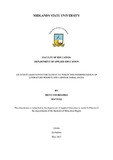Please use this identifier to cite or link to this item:
https://cris.library.msu.ac.zw//handle/11408/2725| Title: | An investigation into the extent to which the interpretation of literature perpetuates gender imbalances | Authors: | Moyo, Thubelihle | Keywords: | Gender stereotypes Gender imbalances |
Issue Date: | 2017 | Publisher: | Midlands State University | Abstract: | This study was an investigation of the extent to which the interpretation of literature perpetuates gender imbalances. Most teachers promote and reinforce gender stereotypes through different ways in which they interpret literature. The evaluation of one’s personality is normally done on basis of their sex. In most cases, inferior language is used to describe women, while superior language is used to describe men. As a result learners are conditioned to a belief that females are less more important than males. Moreover, such a belief may be so rooted into the learners’ minds such that at times it becomes very difficult to break. This study focused on how teachers guide ‘O’ Level students in the interpretation of literature. The study was guided by the following research questions; 1. How does the interpretation of literature perpetuate gender imbalances? a. What theories underpin the interpretation of literature? b. How do teachers perceive male and female characters in texts being studied? C. what symbols of male characters do male learners identify with in texts being studied? d. what symbols of female characters do female learners identify with in texts being studied? e. What can be done to ensure that the interpretation of literature does not perpetuate gender imbalances? The researcher used questionnaires and interviews to collect data for the study. The questionnaires were administered to learners while teachers were interviewed. The population sample consisted of 39 respondents drawn from three different schools in Hwange district. This sample consisted of thirty learners, six teachers and three Heads of English Departments. Probability sampling techniques were employed in the selection of the population sample. Through investigation, it was revealed that classrooms may be sources of gender stereotyping. Therefore, teachers are encouraged to desist from reinforcing gender stereotypes on their learners. Teachers should also try to convince writers and curriculum planners to provide material that is gender responsive to learners. | URI: | http://hdl.handle.net/11408/2725 |
| Appears in Collections: | Bachelor Of Education Degree |
Show full item record
Page view(s)
194
checked on Dec 8, 2025
Download(s)
114
checked on Dec 8, 2025
Google ScholarTM
Check
Items in MSUIR are protected by copyright, with all rights reserved, unless otherwise indicated.




